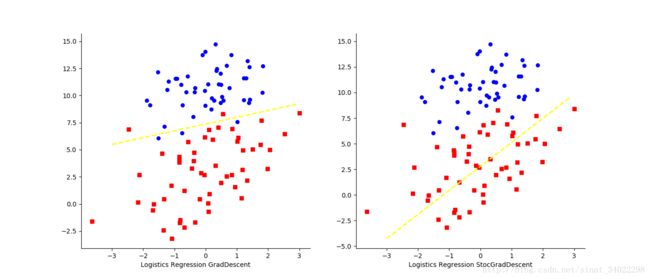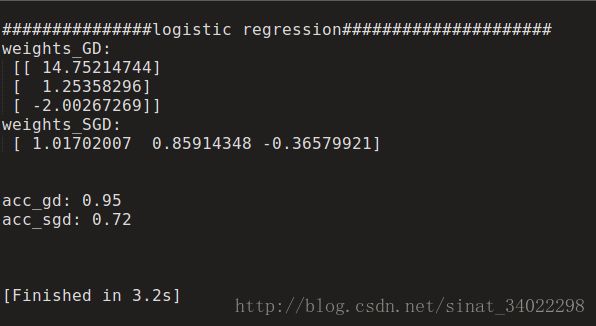逻辑回归----Python实现
逻辑回归是个二分类问题,具体原理网上有很多,这里只列出Python实现过程。
原理参考:逻辑回归
参考《机器学习实战》,对于逻辑回归参数寻优时,采用梯度下降法和随机梯度下降两种方法实现。
Python定义梯度下降函数:
# 梯度下降法
def gardDescent(dataMatIn,classLabels):
dataMatrix = mat(dataMatIn)
labelMatrix = mat(classLabels).T
m,n = shape(dataMatrix) # 得到数据规模
# 迭代步长
alpha = 0.01
# 迭代次数
maxCycles = 5000
weights = ones((n,1)) # help(numpy.ones)
# 设定初始参数,全为1
for k in range(maxCycles):
h = sigmoid(dataMatrix * weights) # sigmoid函数已定义
E = (h - labelMatrix)
weights = weights - alpha * dataMatrix.T * E
return weights
Python定义随机梯度下降函数:
梯度上升算法在每次更新回归系数时都需要遍历整个数据集,一种改进方法是一次仅用一个样本点来更新回归系数,该方法称为随机梯度上升算法。由于可以在新样本到来时对分类器进行增量式更新,因而随机梯度上升算法是一个在线学习算法。与“在线学习 ”相对应 ,一次处理所有数据被称作是“批处理” 。
随机梯度上升算法可以写成如下的伪代码:
所有回归系数初始化为 1
对数据集中每个样本:
计算该样本的梯度
使用 alpha x gradient ^ ,得到新回归系数值
返回回归系数值# 随机梯度上升算法
# 每次对参数的更新都只用一个样本值,属于在线算法
def stocGradAscent0(dataMatrix,classLabels):
dataMatrix = array(dataMatrix)
m,n = shape(dataMatrix)
alpha = 0.01
weights = ones(n)
for i in range(m):
h = sigmoid(sum(dataMatrix[i] * weights))
E = classLabels[i] - h
weights = weights + alpha * E * dataMatrix[i]
return weights可以 看到 ,随机梯度下降算法与梯度下降算法在代码上很相似,但也有一些区别:
- 第一 ,后者的变量 & 和误差 都是向量,而前者则全是数值;
- 第二 ,前者没有矩阵的转换过程,所有变量的数据类型都是 numpy 数组。
Python实现逻辑回归
from numpy import *
import matplotlib.pyplot as plt
print('\n###############logistic regression#####################')
# 载入数据
def loadDataSet():
dataMat = []; labelMat = []
fr = open('testSet.txt')
# 逐行读入数据,然后strip去头去尾,用split分组
for line in fr.readlines():
lineArr = line.strip().split(' ')
dataMat.append([1.0,float(lineArr[0]),float(lineArr[1])])
labelMat.append(int(lineArr[2]))
return dataMat,labelMat
# 定义sigmoid函数
def sigmoid(inX):
return 1.0/(1+exp(-inX))
########## 梯度下降法,见上面 #################
########## 随机梯度下降法,见上面 ##############
# 画图函数,传入参数为两种不同算法得到的参数矩阵
def plotBestFit(weights_1,weights_2):
weights_1 = weights_1.getA() # numpy.matrix.getA():
# Return `self` as an `ndarray` object.
# weights_2 = weights_2.getA()
dataMat,labelMatrix = loadDataSet()
dataArr = array(dataMat)
n = shape(dataArr)[0]
# 使用如下矩阵表示标签不同的两类训练样本
xcord1 = []; ycord1 = []
xcord2 = []; ycord2 = []
# 将训练样本按照标记不同,分为两类不同的点
for i in range(n):
if int(labelMat[i]) == 1:
xcord1.append(dataArr[i,1])
ycord1.append(dataArr[i,2])
else:
xcord2.append(dataArr[i,1])
ycord2.append(dataArr[i,2])
fig = plt.figure(figsize=(14,6))
####################### 图1 ####################
ax = fig.add_subplot(121)
# 画散点图,不同的样本点用不同颜色表示
ax.scatter(xcord1,ycord1,s=30,c='red',marker='s')
ax.scatter(xcord2,ycord2,s=30,c='blue',)
x = arange(-3.0,3.0,0.1)
y_1 = (-weights_1[0]-weights_1[1]*x)/(weights_1[2])
ax.plot(x,y_1,'k--',color = 'yellow',linewidth=2)
plt.xlabel('Logistics Regression GradDescent')
# 去掉坐标系右边和上边的边界,美观
ax.spines['right'].set_color('none')
ax.spines['top'].set_color('none')
####################### 图2 ####################
ax = fig.add_subplot(122)
ax.scatter(xcord1,ycord1,s=30,c='red',marker='s')
ax.scatter(xcord2,ycord2,s=30,c='blue',)
x = arange(-3.0,3.0,0.1)
y_2 = (-weights_2[0]-weights_2[1]*x)/(weights_2[2])
ax.plot(x,y_2,'k--',color = 'yellow',linewidth=2)
plt.xlabel('Logistics Regression StocGradDescent')
ax.spines['right'].set_color('none')
ax.spines['top'].set_color('none')
plt.show()
# 定义准确度计算函数
def calAccuracyRate(dataMat,labelMat,weights):
count = 0
dataMat = mat(dataMat)
labelMat = mat(labelMat).T
m,n = shape(dataMat)
for i in range(m):
h = sigmoid(dataMat[i,:] * weights)
if ( h>0.5 and int(labelMat[i,0]) == 1) or ( h<0.5 and int(labelMat[i,0]) == 0 ):
count += 1
return count/m
dataMat,labelMat = loadDataSet()
weights_GD = gardDescent(dataMat,labelMat) # 使用梯度下降计算参数矩阵 θ
weights_SGD = stocGradAscent0(dataMat,labelMat) # 使用随机梯度下降计算参数矩阵 θ
print('weights_GD:\n',weights_GD)
print('weights_SGD:\n',weights_SGD)
plotBestFit(weights_GD,weights_SGD)
# 计算两种算法结果的准确度
acc_gd = calAccuracyRate(dataMat,labelMat,weights_GD)
weights_SGD = mat(weights_SGD).transpose()
acc_sgd = calAccuracyRate(dataMat,labelMat,weights_SGD)
print('\n\nacc_gd:',acc_gd)
print('acc_sgd:',acc_sgd)
运行结果
运行结果:
准确度:
其中使用梯度下降法等到的准确度为:95%,使用随机梯度下降法准确度:72%。虽然后者准确度差好多,但是后者是在所有样本点上迭代1次的结果,而使用梯度下降法这是迭代了5000次的结果。我们来改进一下随机梯度下降法,将迭代次数增加到500次。
改进随机梯度下降法
# 改进的随机梯度上升算法
def stocGradAscent0(dataMatrix,classLabels):
dataMatrix = array(dataMatrix)
m,n = shape(dataMatrix)
alpha = 0.01
weights = ones(n)
# 在所有样本点上迭代500次
for j in range(500):
for i in range(m):
h = sigmoid(sum(dataMatrix[i] * weights))
E = classLabels[i] - h
weights = weights + alpha * E * dataMatrix[i]
return weights
对比结论
在最优化算法中,最常用的就是梯度下降算法, 而梯度上升算法又可以简化为随机梯度下降算法。
随机梯度下降算法与梯度下降算法的效果相当, 但占用更少的计算资源。此外 ,随机梯度下降是一个在线算法, 它可以在新数据到来时就完成参数更新, 而不需要重新读取整个数据集来进行批处理运算。
数据集
-0.017612 14.053064 0
-1.395634 4.662541 1
-0.752157 6.538620 0
-1.322371 7.152853 0
0.423363 11.054677 0
0.406704 7.067335 1
0.667394 12.741452 0
-2.460150 6.866805 1
0.569411 9.548755 0
-0.026632 10.427743 0
0.850433 6.920334 1
1.347183 13.175500 0
1.176813 3.167020 1
-1.781871 9.097953 0
-0.566606 5.749003 1
0.931635 1.589505 1
-0.024205 6.151823 1
-0.036453 2.690988 1
-0.196949 0.444165 1
1.014459 5.754399 1
1.985298 3.230619 1
-1.693453 -0.557540 1
-0.576525 11.778922 0
-0.346811 -1.678730 1
-2.124484 2.672471 1
1.217916 9.597015 0
-0.733928 9.098687 0
-3.642001 -1.618087 1
0.315985 3.523953 1
1.416614 9.619232 0
-0.386323 3.989286 1
0.556921 8.294984 1
1.224863 11.587360 0
-1.347803 -2.406051 1
1.196604 4.951851 1
0.275221 9.543647 0
0.470575 9.332488 0
-1.889567 9.542662 0
-1.527893 12.150579 0
-1.185247 11.309318 0
-0.445678 3.297303 1
1.042222 6.105155 1
-0.618787 10.320986 0
1.152083 0.548467 1
0.828534 2.676045 1
-1.237728 10.549033 0
-0.683565 -2.166125 1
0.229456 5.921938 1
-0.959885 11.555336 0
0.492911 10.993324 0
0.184992 8.721488 0
-0.355715 10.325976 0
-0.397822 8.058397 0
0.824839 13.730343 0
1.507278 5.027866 1
0.099671 6.835839 1
-0.344008 10.717485 0
1.785928 7.718645 1
-0.918801 11.560217 0
-0.364009 4.747300 1
-0.841722 4.119083 1
0.490426 1.960539 1
-0.007194 9.075792 0
0.356107 12.447863 0
0.342578 12.281162 0
-0.810823 -1.466018 1
2.530777 6.476801 1
1.296683 11.607559 0
0.475487 12.040035 0
-0.783277 11.009725 0
0.074798 11.023650 0
-1.337472 0.468339 1
-0.102781 13.763651 0
-0.147324 2.874846 1
0.518389 9.887035 0
1.015399 7.571882 0
-1.658086 -0.027255 1
1.319944 2.171228 1
2.056216 5.019981 1
-0.851633 4.375691 1
-1.510047 6.061992 0
-1.076637 -3.181888 1
1.821096 10.283990 0
3.010150 8.401766 1
-1.099458 1.688274 1
-0.834872 -1.733869 1
-0.846637 3.849075 1
1.400102 12.628781 0
1.752842 5.468166 1
0.078557 0.059736 1
0.089392 -0.715300 1
1.825662 12.693808 0
0.197445 9.744638 0
0.126117 0.922311 1
-0.679797 1.220530 1
0.677983 2.556666 1
0.761349 10.693862 0
-2.168791 0.143632 1
1.388610 9.341997 0
0.317029 14.739025 0


